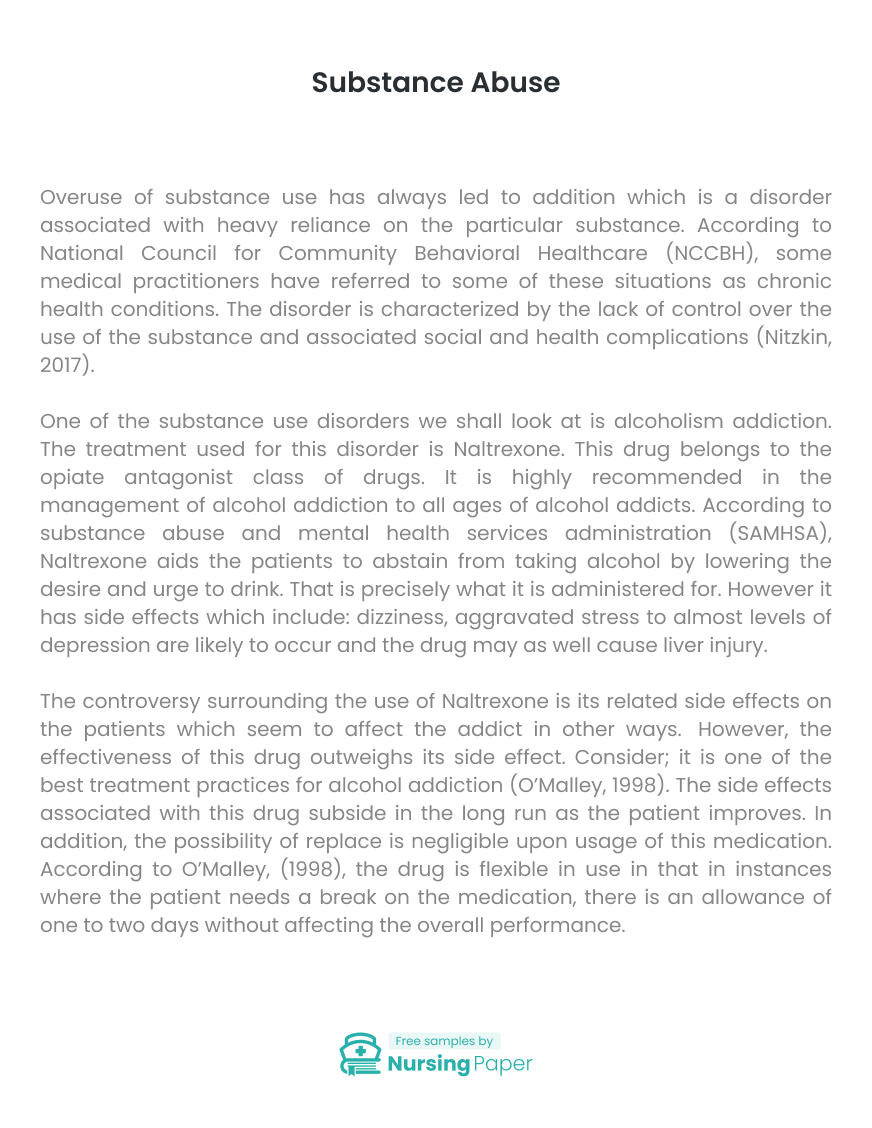
Substance Abuse
Introduction
Overuse of substance use has always led to addition which is a disorder associated with heavy reliance on the particular substance. According to National Council for Community Behavioral Healthcare (NCCBH), some medical practitioners have referred to some of these situations as chronic health conditions. The disorder is characterized by the lack of control over the use of the substance and associated social and health complications (Nitzkin, 2017).
One of the substance use disorders we shall look at is alcoholism addiction. The treatment used for this disorder is Naltrexone. This drug belongs to the opiate antagonist class of drugs. It is highly recommended in the management of alcohol addiction to all ages of alcohol addicts. According to substance abuse and mental health services administration (SAMHSA), Naltrexone aids the patients to abstain from taking alcohol by lowering the desire and urge to drink. That is precisely what it is administered for. However it has side effects which include: dizziness, aggravated stress to almost levels of depression are likely to occur and the drug may as well cause liver injury.


The controversy surrounding the use of Naltrexone is its related side effects on the patients which seem to affect the addict in other ways. However, the effectiveness of this drug outweighs its side effect. Consider; it is one of the best treatment practices for alcohol addiction (O’Malley, 1998). The side effects associated with this drug subside in the long run as the patient improves. In addition, the possibility of replace is negligible upon usage of this medication. According to O’Malley, (1998), the drug is flexible in use in that in instances where the patient needs a break on the medication, there is an allowance of one to two days without affecting the overall performance.
1. NCCBH. Preventing and Treating Substance Use Disorders. Retrieved 2018, July 26 from (2017). Journal of Addiction Research & Therapy.
2. O’Malley, S. S. (1998). Naltrexone and Alcoholism Treatment: Treatment Improvement Protocol (TIP) Series 28.
3. SAMHSA. Clinical Use of Extended Release-Injectable Naltrexone in the Treatment of Opioid Use Disorder. Retrieved 2018, July 26 from http://www.valueoptions.com/providers/Network/NCOC_Government/Naltrexone-Guide-for-Treatment-of-People-with-Opioid-Dependence.pdf



The download will start shortly.

The download will start shortly.
 Subject:
Nursing
Subject:
Nursing  Number of pages: 8
Number of pages: 8  Subject:
Health and Social Care
Subject:
Health and Social Care  Number of pages: 4
Number of pages: 4  Subject:
Nursing
Subject:
Nursing  Number of pages: 4
Number of pages: 4  Subject:
Medicine
Subject:
Medicine  Number of pages: 10
Number of pages: 10  Subject:
Nursing
Subject:
Nursing  Number of pages: 3
Number of pages: 3  Subject:
Health and Social Care
Subject:
Health and Social Care  Number of pages: 6
Number of pages: 6  Subject:
Health and Social Care
Subject:
Health and Social Care  Number of pages: 2
Number of pages: 2  Subject:
Nursing
Subject:
Nursing  Number of pages: 3
Number of pages: 3  Subject:
Medicine
Subject:
Medicine  Number of pages: 3
Number of pages: 3  Subject:
Medicine
Subject:
Medicine  Number of pages: 4
Number of pages: 4  Subject:
Medicine
Subject:
Medicine  Number of pages: 12
Number of pages: 12  Subject:
Health and Social Care
Subject:
Health and Social Care  Number of pages: 2
Number of pages: 2  Subject:
Medicine
Subject:
Medicine  Number of pages: 8
Number of pages: 8  Subject:
Nursing
Subject:
Nursing  Number of pages: 13
Number of pages: 13  Subject:
Nursing
Subject:
Nursing  Number of pages: 5
Number of pages: 5 
